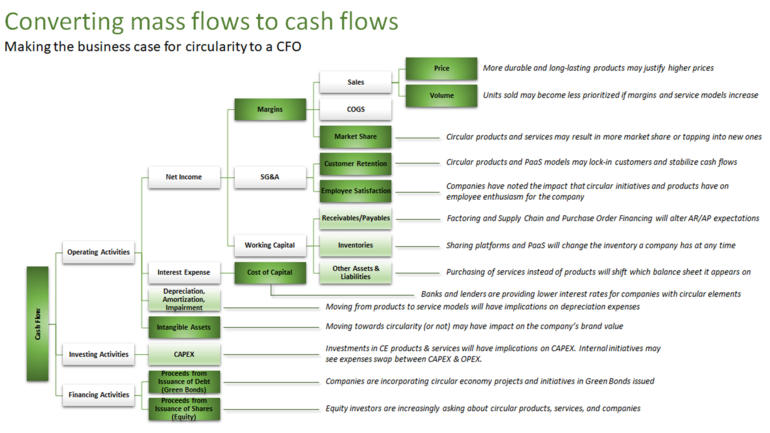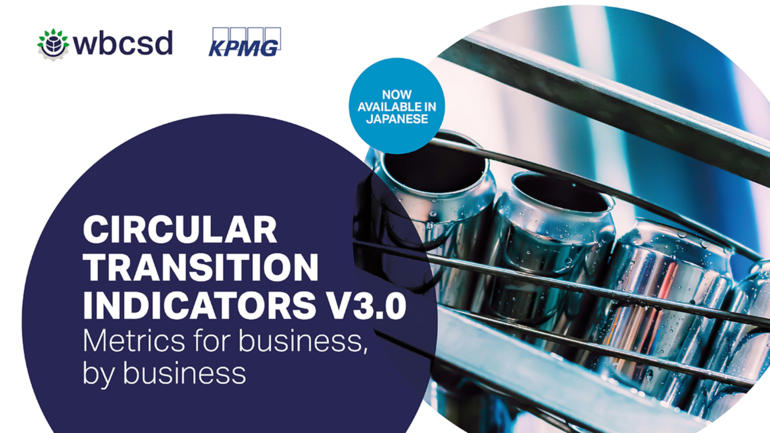The concept of the circular economy resonates with executives from around the world because it presents a remarkable economic opportunity. The fact that it simultaneously delivers environmental benefits is just the icing on the cake.
What is the circular economy? It’s a business strategy that harmonizes financial and environmental priorities. Although not always synonymous with sustainability, the circular economy aligns incentives for “doing well” (economically) and “doing good” (sustainably) by requiring companies to take a life-cycle perspective of their products and services.
The business case for circularity
The USD $4.5 trillion opportunity that the circular economy presents is a number that’s often referenced. However, what does that mean for one company? How do you begin to quantify that?
In 2017, the World Business Council for Sustainable Development (WBCSD) published the 8 Business Cases for the Circular Economy. They cite three types of benefits that a company may experience from adopting circularity in their strategy: accelerating growth, enhancing competitiveness and mitigating risk.
- A company may accelerate financial growth by creating additional revenue through existing products and services, spurring innovation of new products and services or reducing operating costs.
- Competitiveness may be enhanced by strengthening relationships with customers and employees, distinguishing itself further from competition or aligning strategy with the company’s mission.
- Lastly, a business may mitigate risk in adopting circular strategies by avoiding pitfalls of the current linear model or adapting its business model with evolving value chains.
So then, how do you put those general, qualitative benefits into convincing, quantitative justifications?
Building the business case for circularity within your company should be done with the CFO in mind.
Using cash flows to make the case for circularity in your company
In making the business case for circularity, forget the mass flows, speak cash flows!
When speaking to a CFO, remember one thing: “cash is king”. Whether discussing working capital, operating cash flows, current ratios or quick ratios, cash-on-hand and the rate at which it is expected to come into the company are at the top of any CFO’s priority list.
As it’s the financial opportunity that puts the circular economy on the radar of company executives, making the case to a CFO for circularity should be a cash flow discussion.
A company’s cash flows are determined by its operating, investing and financing activities. These three elements provide an architecture for communicating how integrating circularity into the company will affect the business – positively or negatively, it maybe both. In fact, a circular product, service or process will likely affect multiple areas of a company’s cash flows. All these changes should be identified and accounted for in the business model.
For example, the shift from a single-transaction, volume-based business to a service-based business will result in changes to the schedule of cash flows, magnitude of cash flows, allocation of assets and liabilities (including the depreciation costs associated), inventory and more. The identification and quantification of all these impacts allows a company to build a more comprehensive business case by using them as levers to optimize the business model itself.
The diagram below presents a structure for how to estimate and communicate the implications of a company’s circular economy strategy on its cash flows. It can be used as a starting template for building a business case for a specific product, service or project.
Changes in cash flow from Operating Activities
Most of the cash flow implications of a business’s circular economy strategy will fall under Operating Activities.
The subcategories of Operating Expenses that should be considered are Gross Profit, Selling, General and Administrative Expenses (SG&A), Working Capital and Others.
Gross Profit may be affected by:
- higher prices of more durable and long-lasting products;
- lower volumes sold due to shift from single customer transactions to service-based models;
- increase in existing market share or capturing new markets.
SG&A Expenses may be affected by:
- higher customer retention from switching to service-based models;
- lower employee turnover rates due to greater staff satisfaction and enthusiasm.
Working Capital may be affected by:
- shifting responsibilities and scheduling for Accounts Receivable and Accounts Payable;
- changes in inventory in sharing platform and service-based business models compared to single-transaction product models;
- redistribution of assets and liabilities between suppliers and customers due to the shift to service-based models.
Other implications that may affect Operating Activities include:
- changes in the timing of the cash flows, particularly in shifting from single transaction sales models to longer-term access- or service-based models;
- lower cost of capital as banks and lenders provide reduced interest rates for companies with circular commitments;
- changes in depreciation expense when switching to service-based models (positive or negative change depends on whether you’re the service provider of customer);
- changes in brand value due to manifestation of linear risks
Changes in cash flow from Investing and Financing Activities
There are a handful of examples of how circular strategies may impact either Investing or Financing Activity cash flows. In shifting investment priorities from product-purchasing to service-based models, a company may observe that expenses that typically qualified as Capital Expense (CAPEX) may now qualify as Operational Expense (OPEX), or vice versa.
As growth in green bonds issued and investor interest in the circular economy continues, companies will have more support in acquiring debt or equity for further investments in circularity.
Closing the deal
The “business model” concept is used quite loosely when speaking about the circular economy. Unfortunately, it’s not as simple as changing procurement priorities or improving design features.
It demands an understanding of how key value-chain stakeholders are affected by those changes, and whether the value added by that circular upgrade outweighs the cost. Increasingly, that cost should include not just conventional financial costs, but the costs of natural and social capital as well.
To effectively communicate the business case of a circular economy strategy to a CFO, you have to speak their language. That means articulating the qualitative benefits of a circular investment in quantitative terms like cash flow.
In summary, be prepared to answer these questions when communicating the value proposition of your circular solution to your CFO:
- How will this change my cash flows? Be prepared to provide insights into how both the frequency and magnitude of those cash flows will be affected. Starting with the consequences on Accounts Payable and Accounts Receivable may be a helpful place to start.
- How will this change my balance sheet? Understand how your circular business model will impact your company’s assets and liabilities, particularly when considering moving to product-as-a-service models.
- How will this change my cost of capital? Share how your company’s weighted average cost of capital may be affected by your circular business model, including preferential interest rates from banks or changes in tax liability due to federal incentives (see China VAT Policy).
In bringing answers to these questions, your CFO may not just endorse your circular solution but become an advocate for it when convincing the CEO. However, take the underlying message from this article when approaching your CEO: the key points and language used to convince your CEO will be different than those used to secure support from your CFO!









